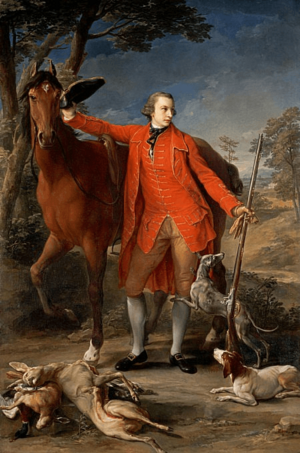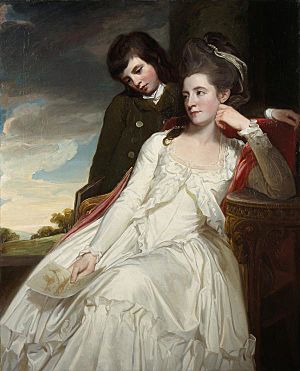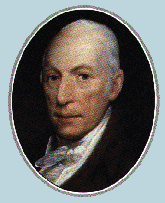Alexander Gordon, 4th Duke of Gordon facts for kids
Quick facts for kids
The Duke of Gordon
|
|
|---|---|
 |
|
| Keeper of the Great Seal of Scotland (1794 to 1806, 1807 to 1827) | |
| Duke of Gordon | |
| Preceded by | Cosmo Gordon |
| Succeeded by | George Gordon |
| Personal details | |
| Born | 18 June 1743 Gordon Castle, Fochabers, Kingdom of Great Britain |
| Died | 17 June 1827 (aged 83) Berkeley Square, London, England |
| Spouses |
|
| Children |
|
| Parents |
|
| Occupation | Nobleman |
Alexander Gordon, 4th Duke of Gordon, KT (18 June 1743 – 17 June 1827), styled Marquess of Huntly until 1752, was a Scottish nobleman, described by Kaimes as the "greatest subject in Britain", and was also known as the Cock o' the North, the traditional epithet attached to the chief of the Gordon clan.
Early life
Alexander Gordon was born at Gordon Castle, Fochabers, on 18 June 1743, the eldest son of Cosmo Gordon, 3rd Duke of Gordon, and his wife, Lady Catherine Gordon, daughter of the 2nd Earl of Aberdeen. He was educated at Eton and also possibly at Harrow. He succeeded as 4th Duke of Gordon in 1752. His younger brother was Lord George Gordon, who incited the Gordon riots.
He was elected as a Scottish representative peer in 1767. In 1778 the government allocated funds to raise three fencible regiments in 'North Britain', one of which was the 'Gordon Fencibles' or North Fencibles' raised by Gordon for the Anglo-French War 1778-83, this was disbanded in 1783. He was appointed a Knight of the Thistle in 1775 and was created a Peer of Great Britain as Baron Gordon of Huntley, of Huntley in the County of Gloucester, and Earl of Norwich, in the County of Norfolk, in 1784. His new titles were not universally popular. He was thought to have taken designations to which he had no right. The Scots Peerage described the Gordon of Huntley peerage as "an absurd specimen of Peerage topography. The village of Huntley, four miles from Newent in Gloucestershire, had apparently no connection with the Gordon family or with the town of Huntly in North Britain." George Edward Cokayne in The Complete Peerage says the following with regard to the Duke's choice of Norwich for his earldom: "His great-grandmother was the daughter of the 5th Duke of Norfolk and 1st Earl of Norwich, but though that title had become extinct in 1777, the representation thereof did not vest in the issue of that lady."
He was Keeper of the Great Seal of Scotland from 1794 to 1806 and from 1807 to 1827. Between 1793 and 1827, he was Chancellor of King's College, Aberdeen. In addition, he was Lord Lieutenant of Aberdeenshire until 1808. He received the Order of the Thistle from King George III on 11 January 1775. The Dictionary of National Biography described him thus: "At the time of his marriage the Duke was reputed one of the handsomest men of his day".
He raised the 92nd (Gordon Highlanders) Regiment of Foot in 1794 for the French Revolutionary Wars. He was responsible for establishing the new village of Fochabers as well as those of Tomintoul and Portgordon in Banffshire. He is also credited as the founder of the Gordon Setter breed of dog, having popularised a 200-year-old breed during the 18th century and then formalised its breed standard in 1820.
He was an enthusiastic supporter and patron of the music of William Marshall (1748–1833), a Scottish fiddler and composer, and famous for his many strathspeys, who acted as steward of the Gordon household.
Marriage and family
Gordon married firstly on 23 October 1767 at Ayton, Scottish Borders, and again at Mr. Fordyce's house in Argyll Street, Edinburgh, Jane, the daughter of the late Sir William Maxwell, 3rd Baronet of Monreith, by his wife, the Lady Magdalen Maxwell, daughter of William Blair, of Blair, Ayrshire. Jane was described by the diarist Sir Nathaniel Wraxall as a celebrated beauty.
The Duke and Duchess's marriage was difficult from the start. For some years before her death, she was bitterly estranged from the Duke. While the Duchess circulated at the centre of society, the Duke lived in retirement at Gordon Castle.
The Duchess is best remembered for placing the King's shilling between her teeth to help recruitment to the Gordon Highlanders which were founded by her husband. However, she also possessed a capacity for match-making which was unrivalled. Of her five daughters, three were married to Dukes (Richmond, Manchester and Bedford) and one to a Marquess (Cornwallis).
The Duchess of Gordon died at Pulteney's Hotel, Piccadilly, Middlesex, on 14 April 1812 and was buried at her beloved Kinrara near Aviemore. After her death Alexander married at the Kirk of Fochabers (probably Bellie) in July 1820, Jane [or Jean] Christie, who was a native of Fochabers and was then aged about 40. Alexander had previously had four children by her.
After their marriage, she lived in great style, not at the castle, but at a townhouse in Fochabers. She claimed that by residing at the Castle, which the Duke had rebuilt and enlarged considerably, none of his friends would visit him.
One of the Duke's illegitimate sons, Colonel Charles Gordon, was given the property of Glasterim near Port Gordon. Curiously, Colonel Gordon had been a great favourite with the late Duchess.
Jane died on 17 June 1824. The Duke himself died suddenly at Mount Street, Berkeley Square, on 17 June 1827, and was buried in Elgin Cathedral. He was succeeded by his son George Gordon, 5th Duke of Gordon.
Legitimate issue
The Duke had a total of seven children by his first wife:
- Lady Charlotte Gordon (Gordon Castle, 20 September 1768 – London, 5 May 1842); married 9 September 1789 at Gordon Castle, Charles Lennox, 4th Duke of Richmond, and had issue. She was the hostess of the Duchess of Richmond's Ball—"the most famous ball in history", and eventually inherited all of the vast estates of the Gordon family.
- George Gordon, 5th Duke of Gordon (Edinburgh, 2 February 1770 – London, 28 May 1836)
- Lady Madelaine Gordon (1772 – 31 May 1847); married firstly 2 April 1789 in London Sir Robert Sinclair, 7th Baronet (died August 1795), and had issue; married secondly 25 November 1805 at Kimbolton Castle Charles Fysche Palmer of Luckley Park, Berkshire with no issue.
- Lady Susan Gordon (Gordon Castle, 2 February 1774 – Bedfont Lodge, 26 August 1828); married 7 October 1793 in Edinburgh, William Montagu, 5th Duke of Manchester, and had issue. Elizabeth Grant of Rothiemurchas in her Memoirs of a Highland Lady noted in 1812 that "the Duchess [of Manchester] had left home years before with one of her footmen", while Lady Jerningham wrote in September 1813 that "The Duchess of Manchester is finally parted from her husband, her conduct being most notoriously bad".
- Lady Louisa Gordon (Gordon Castle, 27 December 1776 – Park Crescent, Middlesex, 5 December 1850); married 17 April 1795 in London, Charles Cornwallis, 2nd Marquess Cornwallis, and had issue. Allegedly, when the Marquess had "expressed to the Duchess of Gordon some hesitation about marrying her daughter on account of the supposed insanity in the Gordon family, he received from the Duchess the gratifying assurance that there was not a drop of Gordon blood in Louisa."
- Lady Georgiana Gordon (Gordon Castle, 18 July 1781 – Nice, 24 February 1853); married 23 June 1803 in London John Russell, 6th Duke of Bedford, and had issue.
- Lord Alexander Gordon (1785 – 8 January 1808); served as an officer in the British Army, unmarried.
Duke's first child with Jane (Jean) was born on April 14, 1818 and was later sent to Australia. He lived on the outskirts of Castlemaine and was known as Boss Aberbeen. He was married to Catherine Mary Aberdeen (born Murphy). The couple had 10 children. Boss died in 1912 in Victoria, Australia.



